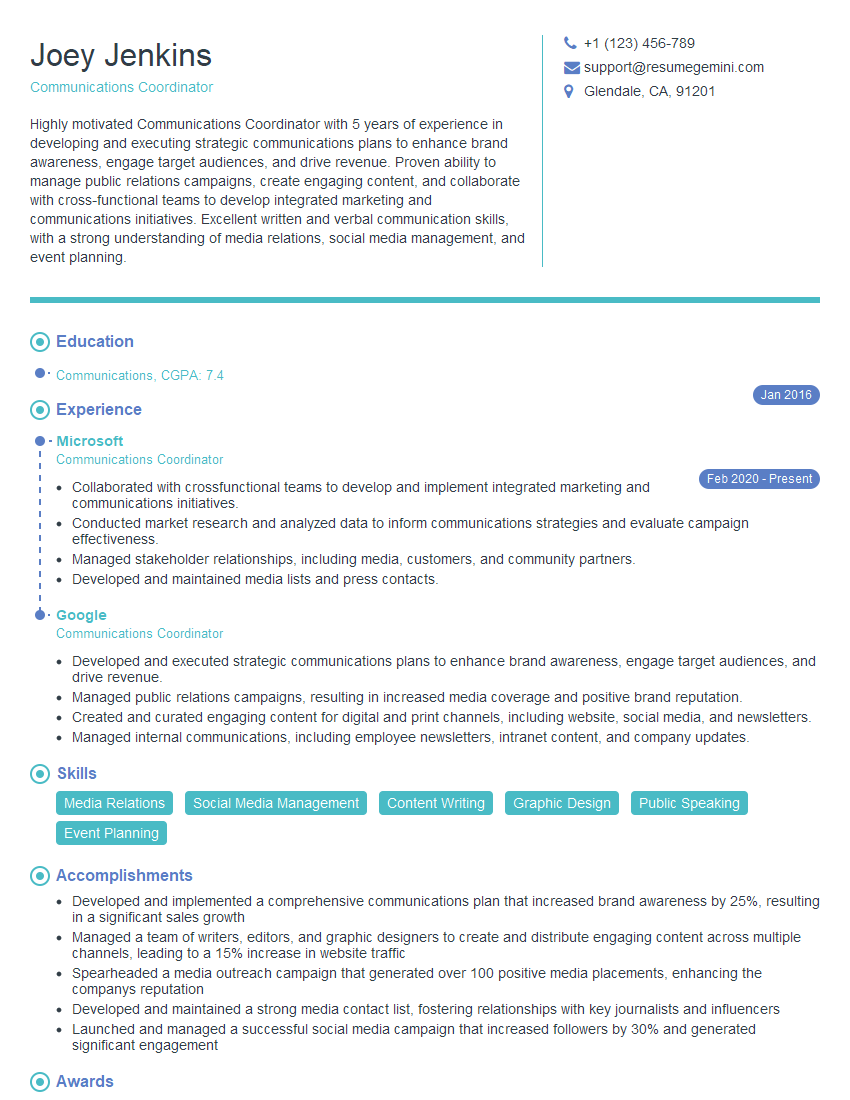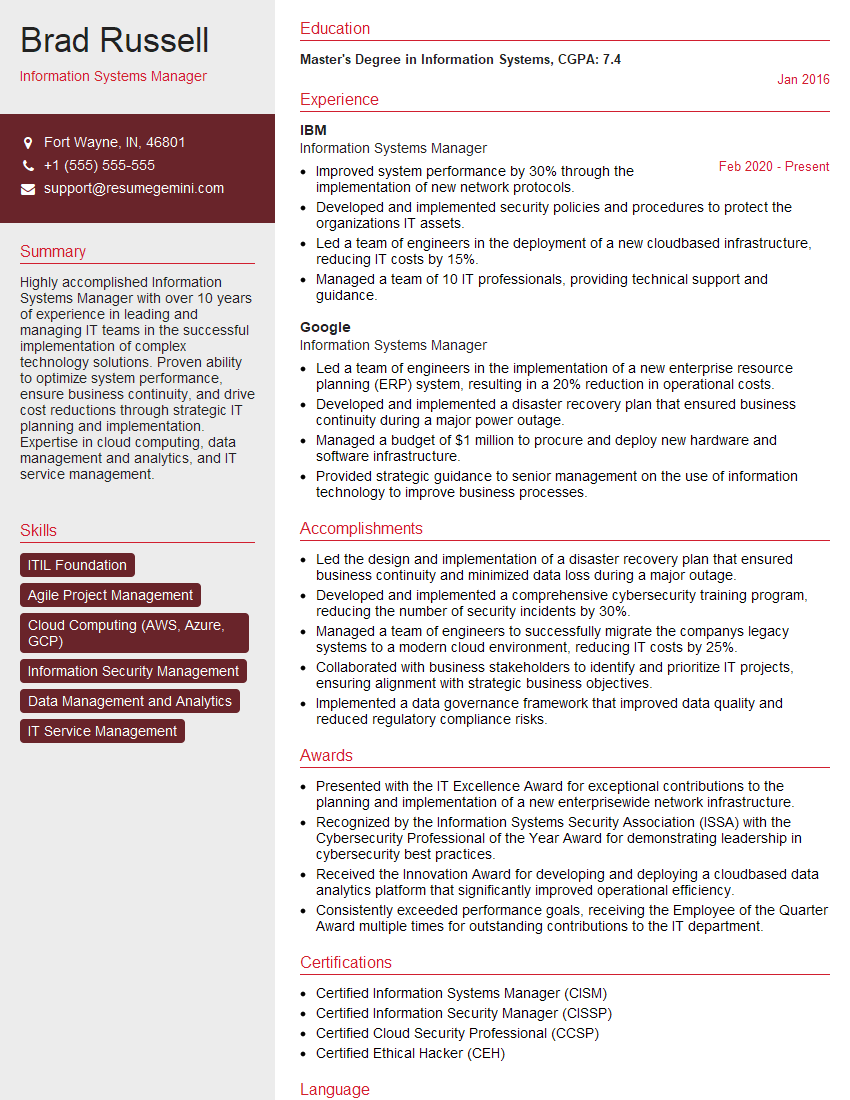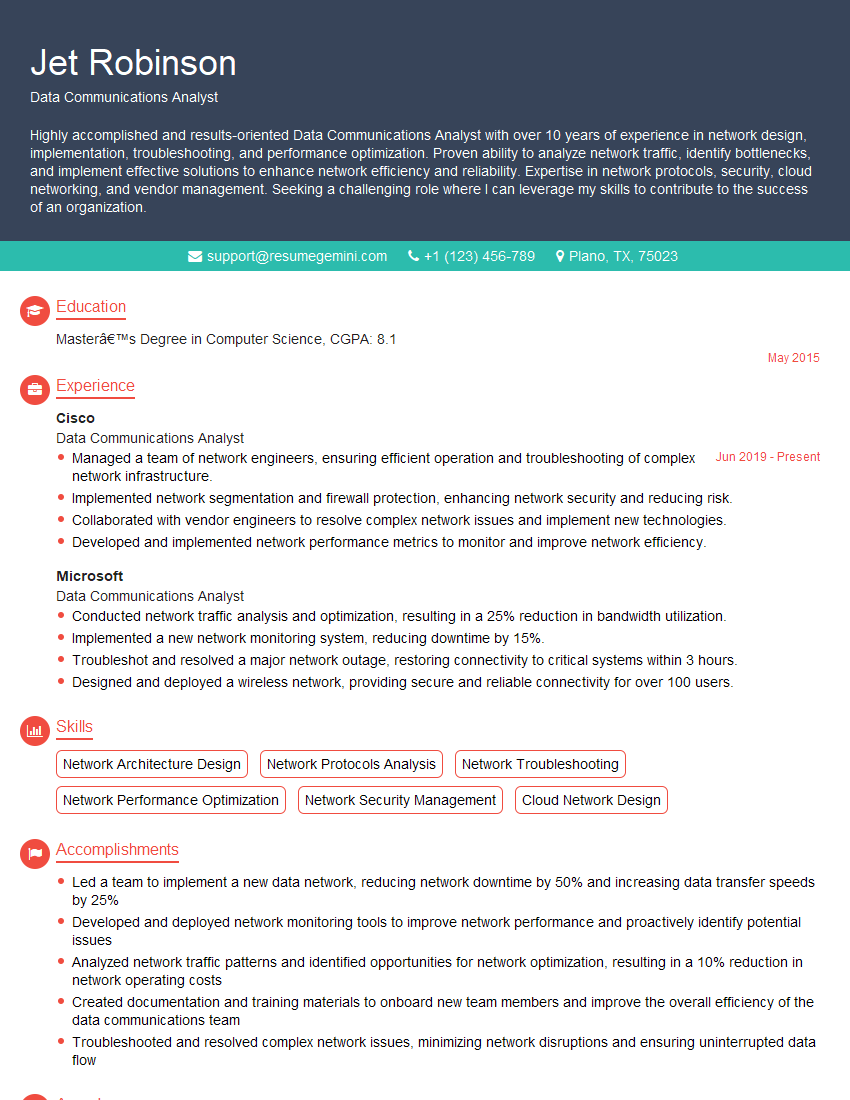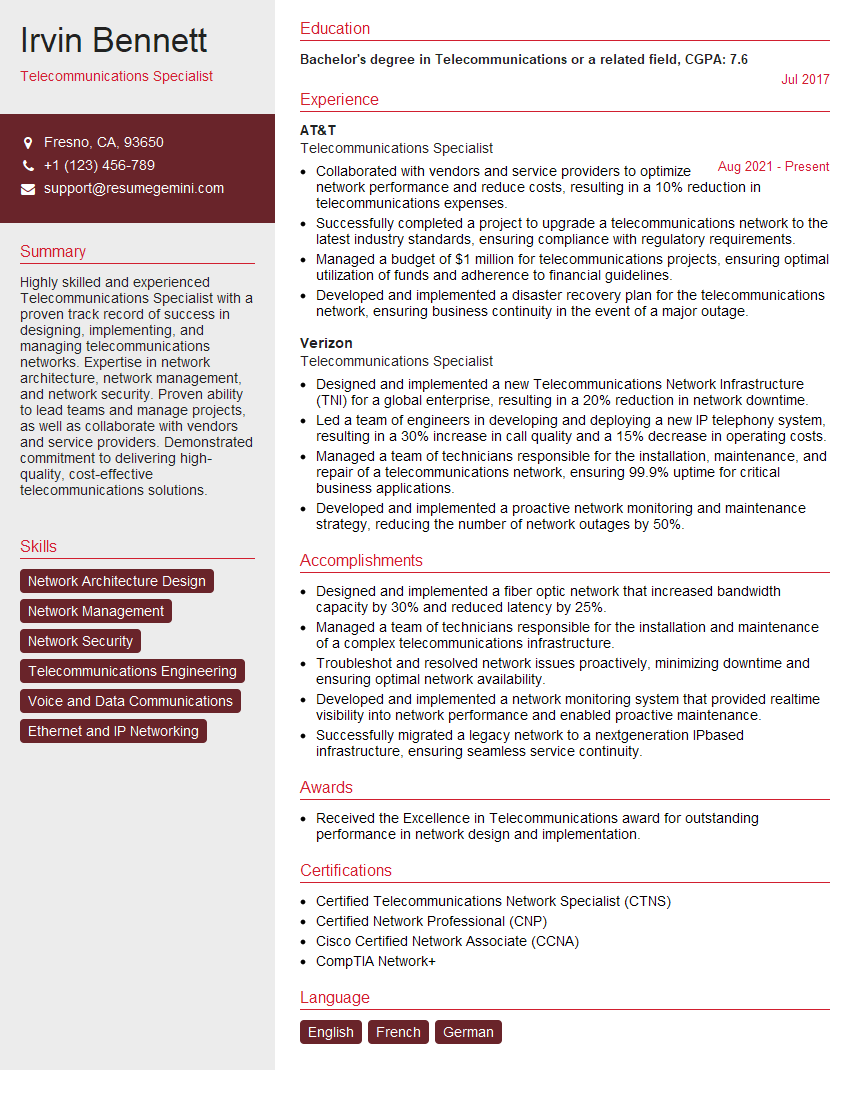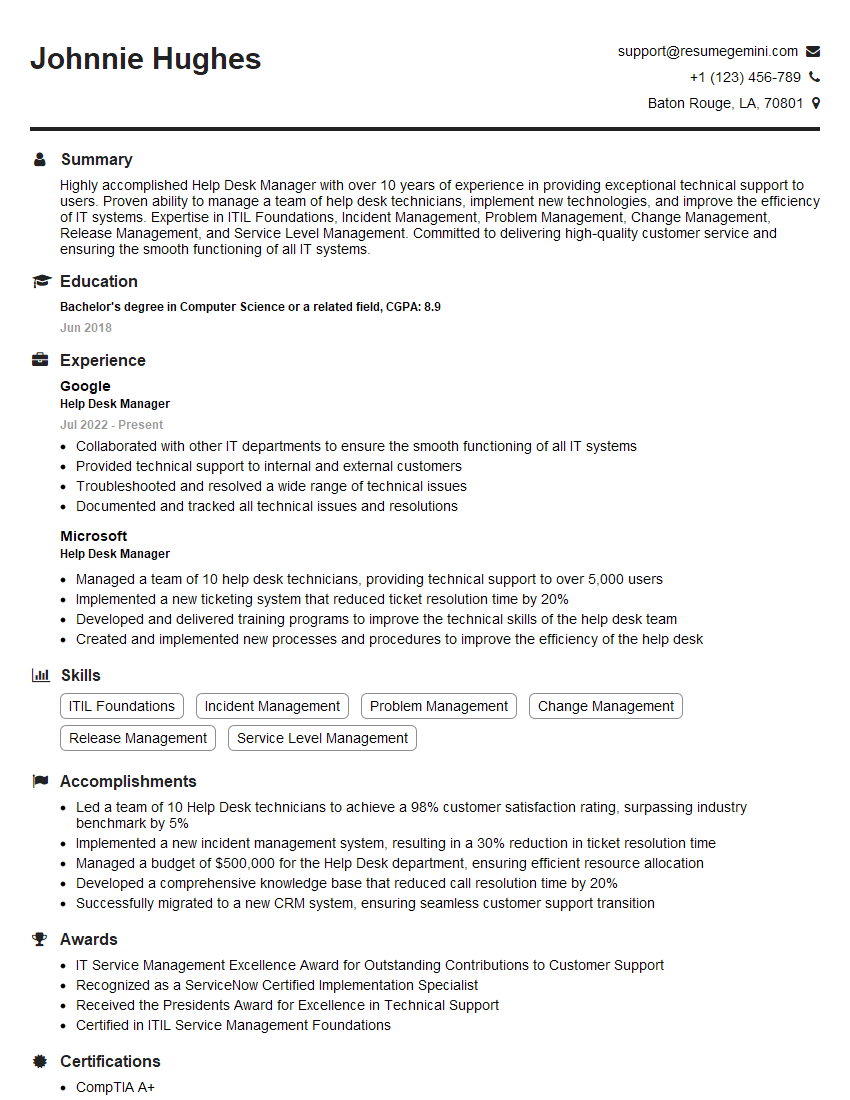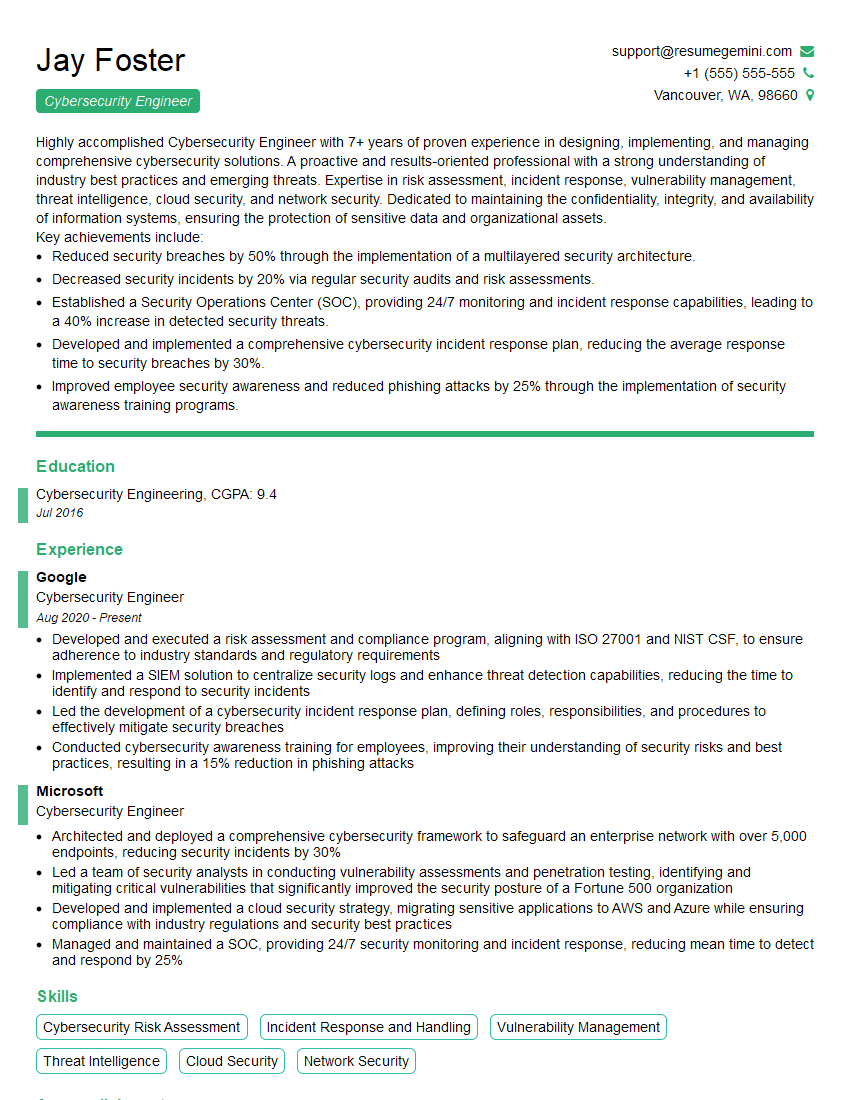The thought of an interview can be nerve-wracking, but the right preparation can make all the difference. Explore this comprehensive guide to Use of Communication Systems and Procedures interview questions and gain the confidence you need to showcase your abilities and secure the role.
Questions Asked in Use of Communication Systems and Procedures Interview
Q 1. Describe your experience with different communication protocols (e.g., TCP/IP, UDP).
My experience with communication protocols spans several years and encompasses a wide range of applications. TCP/IP (Transmission Control Protocol/Internet Protocol) and UDP (User Datagram Protocol) are fundamental protocols forming the backbone of the internet. TCP is a connection-oriented protocol, meaning it establishes a dedicated connection before transmitting data and guarantees reliable delivery. Think of it like sending a registered letter – you know it’s arrived and in the correct order. This makes it ideal for applications requiring reliable data transfer, such as web browsing (HTTP) and email (SMTP). The downside is that establishing a connection adds overhead, making it slower than UDP for certain tasks.
UDP, on the other hand, is connectionless. It’s like sending a postcard – you hope it arrives, but there’s no guarantee. It prioritizes speed over reliability, making it suitable for real-time applications like online gaming and video streaming where a slight delay in some packets is less critical than the overall speed. For example, in online gaming, a few dropped packets might lead to a minor glitch, but a long delay due to TCP’s connection establishment would make the game unplayable.
Beyond TCP and UDP, I’ve worked extensively with protocols like HTTP (Hypertext Transfer Protocol) for web communication, FTP (File Transfer Protocol) for file transfers, and various others depending on the specific application. My experience includes configuring and troubleshooting these protocols in diverse network environments, from small office networks to larger enterprise systems.
Q 2. Explain the difference between synchronous and asynchronous communication.
Synchronous and asynchronous communication differ fundamentally in how they handle timing and interaction. Synchronous communication requires all participants to be present and actively involved at the same time. Imagine a face-to-face meeting or a phone call – everyone participates simultaneously. Response time is immediate, and interaction is real-time. This type of communication is best for situations requiring immediate feedback and collaboration.
Asynchronous communication, conversely, allows participants to communicate at different times. Think of email or text messaging. You send a message, and the recipient can respond whenever they’re available. There’s no requirement for simultaneous presence, offering flexibility. This approach is better suited for tasks that don’t require immediate interaction, allowing for more thoughtful responses and better time management.
The choice between synchronous and asynchronous communication depends entirely on the context. A crisis requires synchronous communication, while project updates might be better handled asynchronously. Effective communication often involves a blend of both approaches to maximize efficiency and collaboration.
Q 3. What troubleshooting steps would you take if a communication system failed?
Troubleshooting a failed communication system requires a systematic approach. My first step is always to define the scope of the failure – what exactly isn’t working? Is it a complete outage, or is only a part of the system affected? Then, I proceed with a structured investigation:
- Check the obvious: Are cables connected properly? Are devices powered on? Are there any physical obstructions affecting network connectivity?
- Test connectivity: Use tools like
pingandtracerouteto verify network connectivity to relevant devices and servers.pingchecks basic connectivity, whiletracerouteshows the path taken by packets, helping to identify points of failure along the way. - Examine logs: Check system and application logs for error messages indicating specific issues. These logs often contain clues about the cause of the failure.
- Isolate the problem: Gradually narrow down the possible sources of the problem. Is it a hardware issue, a software glitch, or a network configuration problem? This often involves isolating affected components and performing tests.
- Escalate if needed: If the problem cannot be resolved using the above steps, it’s important to escalate the issue to a higher-level support team or vendor for further assistance.
My experience helps me quickly diagnose issues and effectively communicate the problem and the proposed solution to both technical and non-technical stakeholders.
Q 4. How familiar are you with network topologies (e.g., star, bus, ring)?
Network topologies describe the physical or logical layout of a network. I’m familiar with several common topologies, including:
- Star topology: All devices connect to a central hub or switch. It’s reliable, easy to manage, and allows for easy expansion. Most home and small office networks use this topology.
- Bus topology: Devices connect to a single cable. Simple to implement, but a single cable failure can bring down the entire network. Less common now due to its limitations.
- Ring topology: Devices connect in a closed loop. Data travels in one direction around the ring. Failure of a single device can disrupt the entire network. Also less common now.
- Mesh topology: Devices connect to multiple other devices, providing redundancy and high availability. Used in critical infrastructure networks.
Understanding these topologies is crucial for designing and troubleshooting networks. The choice of topology depends on factors like network size, scalability requirements, and fault tolerance needs. I have practical experience implementing and maintaining networks using various topologies.
Q 5. Describe your experience with VoIP systems.
My experience with VoIP (Voice over Internet Protocol) systems involves both implementation and troubleshooting. I’ve worked with various VoIP platforms, configuring and managing features such as call routing, voicemail, and conferencing. I understand the underlying protocols like SIP (Session Initiation Protocol) and RTP (Real-time Transport Protocol) that enable VoIP communication. I’ve also dealt with common VoIP challenges, such as poor call quality, dropped calls, and network congestion. These issues often require troubleshooting network configuration, bandwidth allocation, and quality of service (QoS) settings. I have hands-on experience with diagnosing and resolving these problems.
In one particular instance, we had a problem with significant jitter (variation in delay) affecting VoIP calls in a remote office. After investigating the network configuration, I discovered that QoS settings weren’t properly configured on the router, leading to prioritization issues. By adjusting the QoS settings to prioritize VoIP traffic, we drastically improved call quality.
Q 6. How do you ensure data security within communication systems?
Ensuring data security within communication systems is paramount. My approach involves a multi-layered strategy encompassing various security measures:
- Encryption: Using strong encryption protocols like TLS/SSL for secure web communication and VPNs for encrypting all network traffic. This safeguards data in transit.
- Access control: Implementing robust access control mechanisms, including strong passwords, multi-factor authentication, and role-based access control to restrict access to sensitive data and systems.
- Firewalls: Deploying firewalls to control network traffic, blocking unauthorized access attempts and malicious traffic.
- Intrusion detection/prevention systems (IDS/IPS): Implementing IDS/IPS to monitor network traffic for suspicious activity and proactively block potential threats.
- Regular security audits and updates: Conducting regular security audits to identify vulnerabilities and ensuring all systems and software are up-to-date with the latest security patches.
- Security awareness training: Educating users about security best practices to mitigate risks arising from human error.
A layered approach is crucial; relying on a single security measure is insufficient. Data security is an ongoing process requiring continuous monitoring, adaptation, and improvement.
Q 7. Explain your understanding of network security protocols (e.g., firewalls, VPNs).
My understanding of network security protocols is extensive. Firewalls act as a barrier between a network and external threats, filtering traffic based on pre-defined rules. They examine network packets and block or allow them based on criteria such as IP address, port number, and application protocol. Think of it as a bouncer at a club – it only lets in those who meet specific requirements.
VPNs (Virtual Private Networks) create a secure, encrypted tunnel through a public network like the internet. This allows users to access a private network remotely as if they were physically connected. This is particularly important for accessing company resources while working remotely, ensuring confidentiality and security. It’s like having a secret, secure passageway within a public space.
Beyond firewalls and VPNs, I’m also familiar with other protocols like IPSec (Internet Protocol Security) for secure communication between networks, and various authentication protocols like RADIUS and Kerberos for securing access to network resources. Selecting the appropriate protocols depends on the specific security requirements and the network architecture.
Q 8. What experience do you have with managing communication system upgrades or migrations?
Managing communication system upgrades and migrations requires meticulous planning and execution. My experience encompasses various projects, from upgrading legacy email systems to implementing cloud-based unified communication platforms. A recent project involved migrating our organization from an on-premises PBX system to a VoIP solution. This involved a detailed needs assessment, selecting the appropriate vendor and technology (considering factors like scalability, security, and integration with existing systems), developing a comprehensive migration plan with defined timelines and rollback strategies, rigorous testing, and extensive employee training to ensure a smooth transition. We used a phased rollout approach, migrating different departments sequentially to minimize disruption. Post-migration, we established a robust monitoring system to identify and address any unforeseen issues.
Another key aspect is change management. Effectively communicating the changes, their benefits, and potential challenges to all stakeholders – from executive leadership to end-users – is critical for a successful migration. We achieved this through regular updates, training sessions, and readily available support channels.
Q 9. How do you prioritize tasks when multiple communication system issues arise simultaneously?
Prioritizing multiple communication system issues demands a systematic approach. I utilize a framework that combines urgency and impact assessment. I employ a matrix where I rate each issue based on its urgency (how quickly it needs to be addressed) and its impact (how severely it affects operations). Issues are then prioritized based on this matrix; high urgency, high impact issues are addressed first, followed by high impact, lower urgency, and so on. For instance, a complete network outage would be high urgency, high impact, while a minor email delivery delay would be low urgency, low impact.
Communication is key during this process. I ensure transparency with stakeholders, keeping them updated on the progress of addressing each issue. This helps manage expectations and maintain confidence in our ability to resolve the problems effectively. Effective tools like ticketing systems and centralized dashboards help track the status of all open issues.
Q 10. What is your experience with monitoring communication system performance?
Monitoring communication system performance is crucial for maintaining optimal functionality and proactively identifying potential problems. My experience includes using a variety of monitoring tools, from basic network monitoring software to sophisticated unified communications management platforms. These tools provide real-time insights into key metrics such as network latency, packet loss, call quality, and email delivery rates. I set up alerts for critical thresholds, ensuring that I’m notified immediately when a problem arises.
For example, I once used network monitoring software to detect a significant increase in latency on a specific network segment. By investigating further, we discovered a faulty router that was causing the bottleneck. Replacing the router quickly resolved the issue, preventing significant disruption to our operations. Regular performance monitoring not only helps identify and resolve problems, but also allows for capacity planning and future infrastructure upgrades.
Q 11. Describe your experience with various communication technologies (e.g., email, instant messaging, video conferencing).
My experience with communication technologies is extensive and spans various platforms. I’m proficient in email systems (Exchange, Gmail, Outlook), instant messaging platforms (Slack, Microsoft Teams), and video conferencing solutions (Zoom, Webex, Skype). I understand the strengths and limitations of each technology and can advise on their best use cases. For example, I’d recommend email for formal communication, instant messaging for quick exchanges, and video conferencing for collaborative work or remote meetings. My expertise extends to integrating these systems to create a cohesive and efficient communication ecosystem within an organization.
Beyond functional proficiency, I’m aware of security best practices associated with each technology. I’m adept at configuring secure settings, implementing access controls, and educating users on safe communication practices.
Q 12. How familiar are you with different types of communication media (e.g., fiber optics, copper cables)?
I have a strong understanding of different communication media. My knowledge encompasses fiber optic cables, known for their high bandwidth and long-distance transmission capabilities, and copper cables, which are more commonly used for shorter distances and are generally less expensive. I understand the advantages and disadvantages of each. Fiber optics offer superior performance for high-speed data transmission, but are more costly to install and maintain than copper cables. Copper cables are suitable for lower bandwidth applications, but are susceptible to signal degradation over longer distances. The choice between them depends heavily on the specific needs and budget of the communication system.
Furthermore, I’m familiar with wireless technologies like Wi-Fi and cellular networks, understanding their role in modern communication infrastructures and their limitations in terms of bandwidth and security.
Q 13. Explain your understanding of network bandwidth and its impact on communication.
Network bandwidth refers to the amount of data that can be transmitted over a network connection within a given period. It’s measured in bits per second (bps) or multiples thereof (kbps, Mbps, Gbps). Bandwidth significantly impacts communication speed and efficiency. Insufficient bandwidth can lead to slowdowns, delays, dropped calls, and poor video quality. For instance, a low bandwidth connection might make video conferencing choppy or impossible, while high bandwidth allows for smooth, high-definition video and rapid file transfers.
Understanding bandwidth is critical for capacity planning. We must accurately predict bandwidth requirements based on the number of users, applications, and data transfer needs. Over-provisioning can be costly, while under-provisioning can lead to performance issues. Careful bandwidth management through techniques like Quality of Service (QoS) ensures that critical applications receive priority bandwidth.
Q 14. Describe your experience with documenting communication system procedures.
Documenting communication system procedures is paramount for ensuring consistent operations, facilitating troubleshooting, and training new personnel. My experience in documentation includes creating and maintaining comprehensive documentation for various communication systems, ranging from standard operating procedures (SOPs) for troubleshooting common issues to detailed technical documentation for system configuration and maintenance. This includes flowcharts, diagrams, and step-by-step instructions, all written in a clear and concise manner, readily accessible to both technical and non-technical staff.
I use a structured approach to documentation, ensuring it’s regularly updated to reflect changes in the system or processes. This ensures that the documentation remains accurate and relevant. I also employ version control systems to track changes and revert to previous versions if needed. Well-maintained documentation is a cornerstone of efficient communication system management.
Q 15. How do you ensure compliance with relevant communication system regulations?
Ensuring compliance with communication system regulations is paramount for maintaining operational integrity and avoiding legal repercussions. This involves a multi-faceted approach.
- Regular Audits: We conduct periodic audits to verify adherence to standards like GDPR (for data privacy), HIPAA (for healthcare data), and industry-specific regulations. This includes checking data encryption protocols, access controls, and logging procedures.
- Policy Implementation and Training: We develop and implement clear communication policies that align with relevant regulations. Comprehensive training programs for all staff ensure everyone understands their responsibilities regarding data security and communication protocols. This might involve role-playing scenarios to test understanding.
- Staying Updated: The regulatory landscape is constantly evolving. We actively monitor changes and updates to regulations, ensuring our systems and practices remain compliant. This involves subscribing to relevant newsletters and attending industry conferences.
- Third-Party Assessments: For critical systems, we engage independent third-party auditors to perform thorough assessments and provide unbiased reports on our compliance posture. This provides an external verification of our security measures.
- Documentation: Meticulous documentation of all communication systems, security measures, and compliance efforts is crucial for demonstrating our commitment to regulatory adherence. This also aids in troubleshooting and incident response.
For example, in a recent project, we implemented multi-factor authentication across all communication channels to comply with a new data security regulation. This added an extra layer of security and reduced the risk of unauthorized access.
Career Expert Tips:
- Ace those interviews! Prepare effectively by reviewing the Top 50 Most Common Interview Questions on ResumeGemini.
- Navigate your job search with confidence! Explore a wide range of Career Tips on ResumeGemini. Learn about common challenges and recommendations to overcome them.
- Craft the perfect resume! Master the Art of Resume Writing with ResumeGemini’s guide. Showcase your unique qualifications and achievements effectively.
- Don’t miss out on holiday savings! Build your dream resume with ResumeGemini’s ATS optimized templates.
Q 16. Explain your experience with using ticketing systems for communication system issues.
Ticketing systems are indispensable for managing communication system issues efficiently. My experience spans several platforms, including Jira and ServiceNow. I’ve used them to:
- Track Incidents: Each issue, from a network outage to a software glitch, is logged as a ticket, providing a centralized record of the problem, its status, and the steps taken to resolve it.
- Assign Tasks: Tickets are assigned to appropriate team members based on expertise, ensuring efficient resolution. Workflow automation within these systems can automatically route tickets based on predefined rules.
- Monitor Progress: The system allows for real-time monitoring of the resolution process. We can track response times, resolution times, and overall ticket lifecycle.
- Escalate Issues: Critical issues are easily escalated to senior management through built-in escalation workflows, ensuring timely intervention.
- Generate Reports: Ticketing systems generate insightful reports on common issues, resolution times, and overall system performance. This data helps us identify trends and areas for improvement.
For instance, during a recent surge in support requests, the ticketing system’s reporting feature helped us identify a recurring problem in our VoIP system. This allowed for a proactive fix, preventing further disruptions.
Q 17. Describe your experience with disaster recovery planning for communication systems.
Disaster recovery planning for communication systems is crucial for business continuity. My approach involves a multi-layered strategy.
- Risk Assessment: We identify potential threats (natural disasters, cyberattacks, equipment failures) and assess their impact on our communication systems.
- Redundancy and Failover: We implement redundant systems and failover mechanisms to ensure uninterrupted communication in case of failure. This might involve geographically dispersed data centers, backup power generators, and redundant network paths.
- Data Backup and Recovery: Regular backups of critical data are crucial. We use a robust backup and recovery strategy, employing both on-site and off-site backups to protect against data loss.
- Testing and Drills: Regular disaster recovery drills are essential to validate our plans and ensure personnel are prepared to respond effectively. This involves simulating various scenarios and evaluating our response time and effectiveness.
- Communication Plan: A comprehensive communication plan outlines procedures for informing stakeholders (employees, customers) during a disaster. This ensures everyone is aware of the situation and knows how to access essential information.
In one instance, a major hurricane threatened our primary data center. Thanks to our well-tested disaster recovery plan, we seamlessly transitioned to our backup facility, ensuring minimal disruption to our communication services.
Q 18. How do you handle communication breakdowns effectively?
Effective communication breakdown handling requires a structured approach:
- Identify the Problem: Quickly determine the nature and scope of the communication breakdown. Is it a network outage, a software glitch, or a human error?
- Isolate the Cause: Utilize diagnostic tools and techniques to pinpoint the root cause of the breakdown. This may involve checking network connectivity, reviewing logs, and interviewing affected personnel.
- Implement a Solution: Develop and implement a solution to restore communication. This could range from a simple configuration change to a full system restore.
- Communicate Updates: Keep stakeholders informed of the situation, progress, and estimated time of resolution. Transparency builds trust and reduces anxiety.
- Document the Incident: Thoroughly document the incident, including the cause, resolution steps, and lessons learned. This aids in preventing future occurrences.
- Post-Incident Review: Conduct a post-incident review to identify areas for improvement in our communication systems and procedures.
For example, a recent communication outage was traced to a misconfigured firewall rule. By promptly identifying and correcting the rule, we restored communication within minutes and documented the issue to prevent similar problems in the future.
Q 19. What are the key performance indicators (KPIs) you use to measure the effectiveness of communication systems?
Key Performance Indicators (KPIs) are critical for measuring the effectiveness of communication systems. We use a variety of metrics:
- Uptime: The percentage of time the communication system is operational. High uptime indicates system reliability.
- Mean Time To Repair (MTTR): The average time it takes to resolve an issue. A low MTTR signifies efficient problem-solving.
- Mean Time Between Failures (MTBF): The average time between system failures. A high MTBF reflects system robustness.
- Network Latency: The delay in data transmission. Low latency indicates fast and efficient communication.
- Packet Loss: The percentage of data packets lost during transmission. Low packet loss ensures data integrity.
- Customer Satisfaction (CSAT): Measures customer satisfaction with the communication system and support services. High CSAT indicates effective communication and problem resolution.
By regularly monitoring these KPIs, we can identify areas for improvement and optimize the performance of our communication systems.
Q 20. Describe a time you had to explain a technical issue to a non-technical audience.
Explaining technical issues to non-technical audiences requires clear and concise communication. I once had to explain a complex network security breach to a group of executives with limited technical knowledge. I used the following approach:
- Simple Language: Avoided technical jargon and used everyday language to describe the situation. Instead of saying “compromised SSL certificate,” I said “a security flaw that allowed unauthorized access.”
- Analogies and Metaphors: Used relatable analogies to illustrate complex concepts. For instance, I compared the breach to a burglar breaking into a house through a poorly secured door.
- Visual Aids: Used diagrams and charts to visually represent the issue and its impact. A simple flowchart depicting the breach process was particularly helpful.
- Focus on Impact: Emphasized the impact of the breach on the business, such as financial losses and reputational damage, rather than getting bogged down in technical details.
- Q&A Session: Provided ample opportunity for questions and ensured all concerns were addressed clearly and patiently.
By using this approach, I effectively communicated the severity of the issue and its implications, enabling the executives to make informed decisions.
Q 21. What is your experience with various communication system hardware (e.g., routers, switches, modems)?
My experience with communication system hardware encompasses a wide range of devices, including:
- Routers: Extensive experience configuring and troubleshooting Cisco and Juniper routers, including BGP, OSPF, and routing protocols. I’m familiar with various routing technologies and their applications.
- Switches: Proficient in configuring and managing Layer 2 and Layer 3 switches, including VLANs, trunking, and spanning tree protocols. I have practical experience with Cisco Catalyst and Aruba switches.
- Modems: Experience with various types of modems, including DSL, cable, and fiber modems. I understand modem configurations and troubleshooting techniques.
- Firewalls: Experience with configuring and managing firewalls to protect network infrastructure from unauthorized access. Familiar with both hardware and software firewalls (e.g., Palo Alto Networks, Fortinet).
- Load Balancers: Experience with load balancing techniques to distribute network traffic across multiple servers for improved performance and reliability.
I understand the interplay between these hardware components and their role in building a robust and secure communication infrastructure. This includes understanding cabling standards, network topologies, and best practices for network design and implementation.
Q 22. How familiar are you with different types of network security threats?
Network security threats are a constant concern in today’s interconnected world. My familiarity encompasses a wide range, from common threats to more sophisticated attacks. These threats can broadly be categorized:
- Malware: This includes viruses, worms, trojans, ransomware, and spyware, all designed to damage, disrupt, or gain unauthorized access to systems.
- Denial-of-Service (DoS) and Distributed Denial-of-Service (DDoS) attacks: These overwhelm systems with traffic, rendering them unavailable to legitimate users. Imagine a website being flooded with requests until it crashes – that’s a DDoS attack.
- Man-in-the-Middle (MitM) attacks: These involve an attacker intercepting communication between two parties, often to steal data or manipulate the conversation. Think of it like someone secretly listening in on a phone call.
- Phishing and Social Engineering: These attacks manipulate users into revealing sensitive information, like passwords or credit card details, often through deceptive emails or websites. This relies on human error, not technical vulnerabilities.
- SQL Injection: This exploits vulnerabilities in database applications to gain unauthorized access to data. It involves injecting malicious SQL code into input fields to manipulate database queries.
- Zero-Day Exploits: These target vulnerabilities that are unknown to the software developers, making them especially dangerous as there’s no patch available.
Understanding these threats is crucial for implementing appropriate security measures, such as firewalls, intrusion detection systems, and security awareness training for users.
Q 23. Explain your understanding of the OSI model.
The Open Systems Interconnection (OSI) model is a conceptual framework that standardizes the functions of a telecommunication or computing system without regard to its underlying internal structure and technology. It divides communication into seven distinct layers, each with specific responsibilities:
- Physical Layer: Deals with the physical transmission of data, such as cables, connectors, and signals.
- Data Link Layer: Provides error-free transmission of data frames between two directly connected nodes. Think MAC addresses and error detection.
- Network Layer: Handles routing of data packets across networks. IP addresses operate at this layer.
- Transport Layer: Provides reliable and ordered delivery of data segments. TCP and UDP protocols reside here.
- Session Layer: Manages connections between applications, establishing and terminating sessions.
- Presentation Layer: Handles data formatting, encryption, and decryption, ensuring data is presented in a usable format.
- Application Layer: Provides network services to applications, such as HTTP, SMTP, and FTP. This is where users interact with the network.
Understanding the OSI model helps in troubleshooting network issues by isolating problems to specific layers. For example, if a problem exists at the physical layer, it might be a faulty cable; if it’s at the network layer, it might be a routing issue.
Q 24. Describe your experience with cloud-based communication systems.
My experience with cloud-based communication systems is extensive. I’ve worked with various platforms, including Microsoft Teams, Google Workspace (formerly G Suite), and Slack, managing and optimizing their use within organizational settings. This involves:
- Deployment and Configuration: Setting up accounts, integrating with existing systems, and configuring security settings.
- User Training and Support: Educating users on best practices and providing technical support for troubleshooting issues.
- Performance Monitoring and Optimization: Tracking system performance, identifying bottlenecks, and implementing solutions to improve efficiency and reliability. This includes managing bandwidth usage and ensuring low latency.
- Security Management: Implementing and maintaining robust security measures to protect sensitive data. This often involves multi-factor authentication and access controls.
For instance, in a previous role, I migrated a company’s communication system from an on-premise solution to Microsoft Teams. This involved a careful planning phase, user training, data migration, and ongoing monitoring to ensure a seamless transition and improved collaboration.
Q 25. How do you stay updated on the latest advancements in communication systems?
Staying current in the rapidly evolving field of communication systems requires a multi-faceted approach:
- Industry Publications and Journals: I regularly read publications like IEEE Communications Magazine and others to stay informed about research and technological advancements.
- Conferences and Workshops: Attending conferences like Cisco Live or industry-specific workshops allows for networking and learning from leading experts.
- Online Courses and Webinars: Platforms like Coursera, edX, and LinkedIn Learning offer courses on various aspects of communication systems, allowing for continuous learning and skill development.
- Professional Organizations: Membership in professional organizations like the IEEE provides access to resources, publications, and networking opportunities.
- Vendor Websites and Documentation: Keeping up-to-date with the latest releases and features offered by major vendors like Cisco, Juniper, and others.
This combination of active learning and networking ensures I possess the most current knowledge and best practices within the field.
Q 26. What is your experience with different types of data encryption?
My experience with data encryption involves several types, each with different strengths and weaknesses:
- Symmetric Encryption: Uses the same key for both encryption and decryption. Examples include AES (Advanced Encryption Standard) and DES (Data Encryption Standard). It’s faster but requires secure key exchange.
- Asymmetric Encryption: Uses two keys – a public key for encryption and a private key for decryption. RSA (Rivest-Shamir-Adleman) is a common example. It’s slower but doesn’t require secure key exchange.
- Hashing Algorithms: These generate a one-way function, creating a fixed-size hash value from any input data. SHA-256 and MD5 are examples. They’re used for data integrity verification, not encryption.
The choice of encryption method depends on the specific security requirements and the sensitivity of the data. For example, HTTPS uses a combination of symmetric and asymmetric encryption to secure web traffic.
Q 27. How do you ensure the integrity of data transmitted through communication systems?
Ensuring data integrity during transmission involves several strategies:
- Error Detection Codes: Techniques like checksums and cyclic redundancy checks (CRCs) are used to detect errors introduced during transmission. If an error is detected, the data can be retransmitted.
- Digital Signatures: These use asymmetric cryptography to verify the authenticity and integrity of data. They ensure the data hasn’t been tampered with and comes from a trusted source.
- Message Authentication Codes (MACs): These provide authentication and data integrity verification. They combine a secret key with the data to generate a tag that can be verified by the receiver.
- Data Encryption: As mentioned earlier, encryption protects data from unauthorized access, ensuring only authorized parties can view it. This also indirectly protects integrity, as unauthorized modification would be detectable.
A layered approach, combining several of these methods, offers the strongest protection against data corruption and unauthorized modification.
Q 28. Describe a situation where you had to improve the efficiency of a communication system.
In a previous role, our company’s internal communication system, reliant on email and shared drives, was becoming increasingly inefficient. Emails were getting lost in lengthy threads, file versions were inconsistent, and collaboration was hampered by the lack of a centralized platform.
To improve efficiency, I implemented a phased approach:
- Needs Assessment: I conducted surveys and interviews to understand user needs and pain points.
- Solution Selection: Based on the assessment, we chose a cloud-based collaboration platform (Microsoft Teams in this case) offering features like chat, file sharing, and video conferencing.
- Implementation and Training: We rolled out the platform in phases, providing thorough training to users. This involved both technical training and best practice guidelines for effective collaboration.
- Monitoring and Optimization: We continuously monitored usage patterns and adjusted configurations to maximize efficiency. This included setting up appropriate permissions and managing storage space.
The result was a significant improvement in communication efficiency. Collaboration became smoother, information flow improved, and overall productivity increased. The transition involved careful planning and change management to ensure user buy-in and a smooth transition.
Key Topics to Learn for Use of Communication Systems and Procedures Interview
- Communication Protocols: Understanding TCP/IP, UDP, HTTP, and other relevant protocols. Consider practical scenarios where you’ve chosen a specific protocol and why.
- Network Topologies and Architectures: Familiarize yourself with common network designs (e.g., star, bus, ring, mesh) and their strengths/weaknesses. Be prepared to discuss how these impact communication efficiency and security.
- Data Security and Encryption: Discuss methods used to secure communication channels (e.g., firewalls, VPNs, encryption algorithms). Think about practical applications and potential vulnerabilities.
- Troubleshooting Communication Issues: Practice diagnosing and resolving common communication problems. Develop a structured approach to troubleshooting, highlighting your problem-solving skills.
- Communication System Design and Implementation: Understand the principles involved in designing and implementing communication systems, considering factors like scalability, reliability, and maintainability. Prepare examples of your involvement in such projects.
- Compliance and Regulations: Review relevant industry regulations and compliance standards related to data security and communication protocols within your field.
- Collaboration and Teamwork in Communication: Prepare examples showcasing your ability to effectively communicate and collaborate within a team environment using various communication tools and methods.
Next Steps
Mastering Use of Communication Systems and Procedures is crucial for career advancement in today’s interconnected world. Strong communication skills and a deep understanding of these systems are highly valued by employers across various industries. To significantly boost your job prospects, focus on creating an ATS-friendly resume that effectively highlights your skills and experience. ResumeGemini is a trusted resource that can help you build a professional and impactful resume. Take advantage of their tools and resources to craft a compelling document. Examples of resumes tailored to showcasing expertise in Use of Communication Systems and Procedures are available to guide you.
Explore more articles
Users Rating of Our Blogs
Share Your Experience
We value your feedback! Please rate our content and share your thoughts (optional).
What Readers Say About Our Blog
Hello,
We found issues with your domain’s email setup that may be sending your messages to spam or blocking them completely. InboxShield Mini shows you how to fix it in minutes — no tech skills required.
Scan your domain now for details: https://inboxshield-mini.com/
— Adam @ InboxShield Mini
Reply STOP to unsubscribe
Hi, are you owner of interviewgemini.com? What if I told you I could help you find extra time in your schedule, reconnect with leads you didn’t even realize you missed, and bring in more “I want to work with you” conversations, without increasing your ad spend or hiring a full-time employee?
All with a flexible, budget-friendly service that could easily pay for itself. Sounds good?
Would it be nice to jump on a quick 10-minute call so I can show you exactly how we make this work?
Best,
Hapei
Marketing Director
Hey, I know you’re the owner of interviewgemini.com. I’ll be quick.
Fundraising for your business is tough and time-consuming. We make it easier by guaranteeing two private investor meetings each month, for six months. No demos, no pitch events – just direct introductions to active investors matched to your startup.
If youR17;re raising, this could help you build real momentum. Want me to send more info?
Hi, I represent an SEO company that specialises in getting you AI citations and higher rankings on Google. I’d like to offer you a 100% free SEO audit for your website. Would you be interested?
Hi, I represent an SEO company that specialises in getting you AI citations and higher rankings on Google. I’d like to offer you a 100% free SEO audit for your website. Would you be interested?
good
